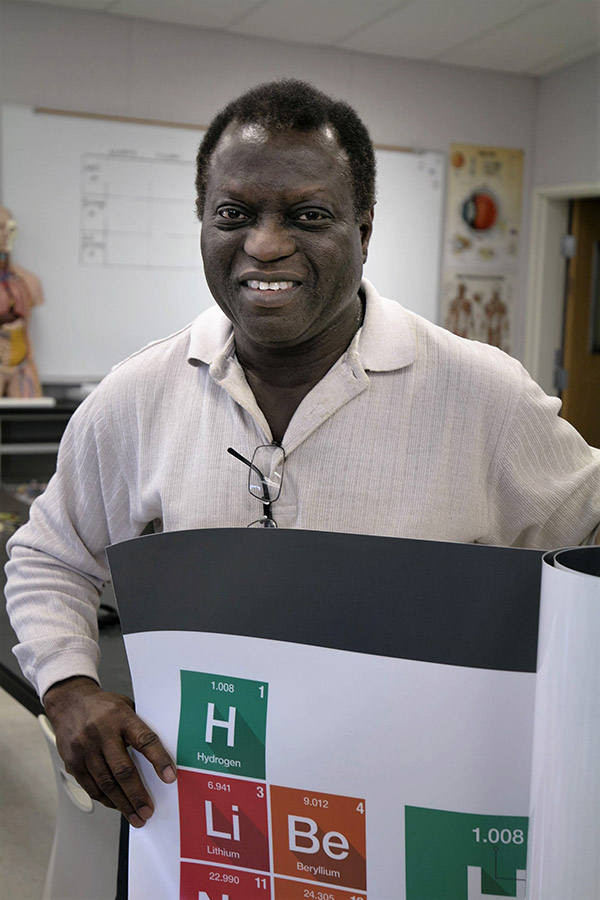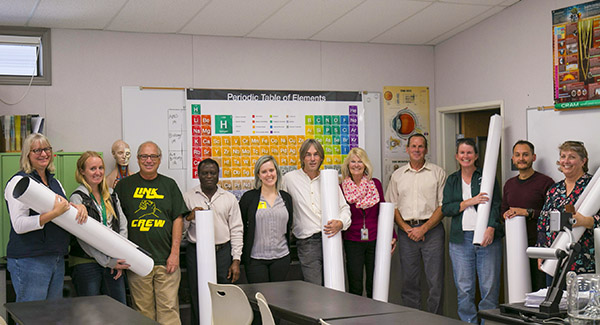Sandia supplies essential element to local science classrooms
Thanks to a donation by Sandia, public high schools in Livermore now sport colorful, extra-large periodic tables that include the city’s namesake element, Livermorium.
Livermorium is a synthetic element discovered though experiments at Lawrence Livermore National Laboratory and the Joint Institute for Nuclear Research in Russia. The International Union of Pure and Applied Chemistry adopted it in 2012.
“Our science teachers at both Livermore and Granada high schools are thrilled to have current periodic tables that include all of the elements, especially Livermorium,” says Livermore Valley Joint Unified School District Superintendent Kelly Bowers.
The idea to donate the custom designed, up-to-date periodic tables came from conversations last fall between Sandia Community Relations Officer Madeline Burchard and local Livermore science teachers. The teachers indicated then that their classroom tables were outdated and missing new elements including Livermorium and Lawrencium.

Madeline, who holds a degree in molecular environmental biology from the University of California, Berkeley, believed this was something Sandia could and should help fix.
“My own chemistry teachers in college had me memorize the table because the information it contains is so crucial for understanding how atoms interact with each other,” she says.

Livermore High School science teachers pose with Sandia Community Relations Officer Madeline Burchard (center), holding their new classroom tables.
Madeline worked with Sandia designer Loren Stacks to create the 6-by-4 tables, then surprised the teachers with them in their department meetings this fall. Reaction has been universally positive from both teachers and students.
Granada high school senior and Sandia intern Emma Zika says, “I think the tables are going to be really useful tools, especially for the freshmen and sophomores at the beginning of their science journeys.” In reference to Sandia’s thunderbird logo on the tables, Emma adds, “It’s really cool to see Sandia represented on campus, and to know the Laboratories care about our education.”
Livermore High School life science teacher Elias Fiadoyor says that prior to receiving his table, the one in his classroom was very small. “This one, students all the way in the back will be able to see it! I will have to find a way to cover it during exams,” he jokes.
Smaller, 8.5-by-11 versions of the larger tables are available for downloading and printing.
The table donations are part of Sandia’s long-standing efforts to engage with and support the local community. Other popular community involvement programs that Sandia sponsors include:
- Family Science Night — a traveling science fair that sets up weekly at different elementary schools in the San Joaquin and Tri-Valley areas.
- Sandia Regional Science Bowl — a quiz-bowl-style, fast-paced science competition that tests local middle and high school teams on their knowledge in a range of scientific disciplines, including biology, chemistry, earth sciences, physics, and math. The winning team is sent to Washington, D.C., to represent the region in a national competition.
- Sandia Women’s Connection Math and Science Awards — This awards program recognizes high-achieving young women for their accomplishments in science, technology, engineering, and math subjects, and encourages their future scholarship by pairing them with Sandia mentors. Nominees are selected by teachers from more than 16 Northern California high schools.
“We live in a community rich in scientific research and innovation,” says Bowers. “Sandia’s strong partnership with our schools, exemplified by this donation, will help ensure our students stay on the cutting edge of scientific discovery.”